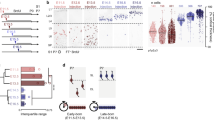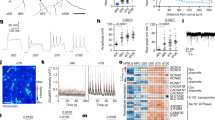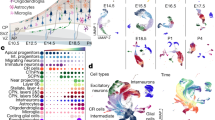Abstract
In the developing cerebral cortex, neurons are born on a predictable schedule. Here we show in mice that the essential timing mechanism is programmed within individual progenitor cells, and its expression depends solely on cell-intrinsic and environmental factors generated within the clonal lineage. Multipotent progenitor cells undergo repeated asymmetric divisions, sequentially generating neurons in their normal in vivo order: first preplate cells, including Cajal-Retzius neurons, then deep and finally superficial cortical plate neurons. As each cortical layer arises, stem cells and neuroblasts become restricted from generating earlier-born neuron types. Growth as neurospheres or in co-culture with younger cells did not restore their plasticity. Using short-hairpin RNA (shRNA) to reduce Foxg1 expression reset the timing of mid- but not late-gestation progenitors, allowing them to remake preplate neurons and then cortical-plate neurons. Our data demonstrate that neural stem cells change neuropotency during development and have a window of plasticity when restrictions can be reversed.
This is a preview of subscription content, access via your institution
Access options
Subscribe to this journal
Receive 12 print issues and online access
$209.00 per year
only $17.42 per issue
Buy this article
- Purchase on Springer Link
- Instant access to full article PDF
Prices may be subject to local taxes which are calculated during checkout





Similar content being viewed by others
References
Bayer, S.A. & Altman, J. Neocortical Development (Raven Press, New York, 1991).
Sulston, J.E. & Horvitz, H.R. Post-embryonic cell lineages of the nematode, Caenorhabditis elegans. Dev. Biol. 56, 110–156 (1977).
Sulston, J.E., Schierenberg, E., White, J.G. & Thomson, J.N. The embryonic cell lineage of the nematode Caenorhabditis elegans. Dev. Biol. 100, 64–119 (1983).
Doe, C.Q. & Technau, G.M. Identification and cell lineage of individual neural precursors in the Drosophila CNS. Trends Neurosci. 16, 510–514 (1993).
McConnell, S.K. & Kaznowski, C.E. Cell cycle dependence of laminar determination in developing neocortex. Science 254, 282–285 (1991).
Frantz, G.D. & McConnell, S.K. Restriction of late cerebral cortical progenitors to an upper-layer fate. Neuron 17, 55–61 (1996).
Desai, A.R. & McConnell, S.K. Progressive restriction in fate potential by neural progenitors during cerebral cortical development. Development 127, 2863–2872 (2000).
Qian, X. et al. Timing of CNS cell generation: a programmed sequence of neuron and glial cell production from isolated murine cortical stem cells. Neuron 28, 69–80 (2000).
Ware, M.L., Tavazoie, S.F., Reid, C.B. & Walsh, C.A. Coexistence of widespread clones and large radial clones in early embryonic ferret cortex. Cereb. Cortex 9, 636–645 (1999).
Takiguchi-Hayashi, K. et al. Generation of reelin-positive marginal zone cells from the caudomedial wall of telencephalic vesicles. J. Neurosci. 24, 2286–2295 (2004).
Lavdas, A.A., Grigoriou, M., Pachnis, V. & Parnavelas, J.G. The medial ganglionic eminence gives rise to a population of early neurons in the developing cerebral cortex. J. Neurosci. 19, 7881–7888 (1999).
Bielle, F. et al. Multiple origins of Cajal-Retzius cells at the borders of the developing pallium. Nat. Neurosci. 8, 1002–1012 (2005).
Hanashima, C., Li, S.C., Shen, L., Lai, E. & Fishell, G. Foxg1 suppresses early cortical cell fate. Science 303, 56–59 (2004).
Noctor, S.C., Martinez-Cerdeno, V., Ivic, L. & Kriegstein, A.R. Cortical neurons arise in symmetric and asymmetric division zones and migrate through specific phases. Nat. Neurosci. 7, 136–144 (2004).
Miyata, T. et al. Asymmetric production of surface-dividing and non-surface-dividing cortical progenitor cells. Development 131, 3133–3145 (2004).
Haubensak, W., Attardo, A., Denk, W. & Huttner, W.B. Neurons arise in the basal neuroepithelium of the early mammalian telencephalon: A major site of neurogenesis. Proc. Natl. Acad. Sci. USA 101, 3196–3201 (2004).
Nadarajah, B., Alifragis, P., Wong, R.O. & Parnavelas, J.G. Neuronal migration in the developing cerebral cortex: observations based on real-time imaging. Cereb. Cortex 13, 607–611 (2003).
Qian, X., Goderie, S.K., Shen, Q., Stern, J.H. & Temple, S. Intrinsic programs of patterned cell lineages in isolated vertebrate CNS ventricular zone cells. Development 125, 3143–3152 (1998).
D'Arcangelo, G. et al. Reelin is a secreted glycoprotein recognized by the CR-50 monoclonal antibody. J. Neurosci. 17, 23–31 (1997).
Ferland, R.J., Cherry, T.J., Preware, P.O., Morrisey, E.E. & Walsh, C.A. Characterization of Foxp2 and Foxp1 mRNA and protein in the developing and mature brain. J. Comp. Neurol. 460, 266–279 (2003).
Koop, K.E., MacDonald, L.M. & Lobe, C.G. Transcripts of Grg4, a murine groucho-related gene, are detected in adjacent tissues to other murine neurogenic gene homologues during embryonic development. Mech. Dev. 59, 73–87 (1996).
Yao, J. et al. Combinatorial expression patterns of individual TLE proteins during cell determination and differentiation suggest non-redundant functions for mammalian homologs of Drosophila Groucho. Dev. Growth Differ. 40, 133–146 (1998).
Hevner, R.F. et al. Beyond laminar fate: toward a molecular classification of cortical projection/pyramidal neurons. Dev. Neurosci. 25, 139–151 (2003).
Nieto, M. et al. Expression of Cux-1 and Cux-2 in the subventricular zone and upper layers II–IV of the cerebral cortex. J. Comp. Neurol. 479, 168–180 (2004).
Hevner, R.F., Neogi, T., Englund, C., Daza, R.A. & Fink, A. Cajal-Retzius cells in the mouse: transcription factors, neurotransmitters, and birthdays suggest a pallial origin. Brain Res. Dev. Brain Res. 141, 39–53 (2003).
Shen, Q., Qian, X., Capela, A. & Temple, S. Stem cells in the embryonic cerebral cortex: their role in histogenesis and patterning. J. Neurobiol. 36, 162–174 (1998).
Caviness, V.S., Jr., Takahashi, T. & Nowakowski, R.S. Numbers, time and neocortical neuronogenesis: a general developmental and evolutionary model. Trends Neurosci. 18, 379–383 (1995).
Calegari, F., Haubensak, W., Haffner, C. & Huttner, W.B. Selective lengthening of the cell cycle in the neurogenic subpopulation of neural progenitor cells during mouse brain development. J. Neurosci. 25, 6533–6538 (2005).
Al-Kofahi, O. et al. Automated cell lineage construction: A rapid method to analyze clonal development established with murine neural progenitor cells. Cell Cycle 5, 327–335 (2006).
Polleux, F., Dehay, C. & Kennedy, H. The timetable of laminar neurogenesis contributes to the specification of cortical areas in mouse isocortex. J. Comp. Neurol. 385, 95–116 (1997).
Luskin, M.B., Pearlman, A.L. & Sanes, J.R. Cell lineage in the cerebral cortex of the mouse studied in vivo and in vitro with a recombinant retrovirus. Neuron 1, 635–647 (1988).
Kornack, D.R. & Rakic, P. Radial and horizontal deployment of clonally related cells in the primate neocortex: relationship to distinct mitotic lineages. Neuron 15, 311–321 (1995).
Reid, C.B., Liang, I. & Walsh, C. Systematic widespread clonal organization in cerebral cortex. Neuron 15, 299–310 (1995).
Morrow, T., Song, M.R. & Ghosh, A. Sequential specification of neurons and glia by developmentally regulated extracellular factors. Development 128, 3585–3594 (2001).
Barnabe-Heider, F. et al. Evidence that embryonic neurons regulate the onset of cortical gliogenesis via cardiotrophin-1. Neuron 48, 253–265 (2005).
Xuan, S. et al. Winged helix transcription factor BF-1 is essential for the development of the cerebral hemispheres. Neuron 14, 1141–1152 (1995).
Muzio, L. & Mallamaci, A. Foxg1 confines Cajal-Retzius neuronogenesis and hippocampal morphogenesis to the dorsomedial pallium. J. Neurosci. 25, 4435–4441 (2005).
Isshiki, T. & Doe, C.Q. Maintaining youth in Drosophila neural progenitors. Cell Cycle 3, 296–299 (2004).
Grosskortenhaus, R., Pearson, B.J., Marusich, A. & Doe, C.Q. Regulation of temporal identity transitions in Drosophila neuroblasts. Dev. Cell 8, 193–202 (2005).
Reid, C.B., Tavazoie, S.F. & Walsh, C.A. Clonal dispersion and evidence for asymmetric cell division in ferret cortex. Development 124, 2441–2450 (1997).
Shen, Q., Zhong, W., Jan, Y.N. & Temple, S. Asymmetric Numb distribution is critical for asymmetric cell division of mouse cerebral cortical stem cells and neuroblasts. Development 129, 4843–4853 (2002).
Li, H.S. et al. Inactivation of Numb and Numblike in embryonic dorsal forebrain impairs neurogenesis and disrupts cortical morphogenesis. Neuron 40, 1105–1118 (2003).
Martynoga, B., Morrison, H., Price, D.J. & Mason, J.O. Foxg1 is required for specification of ventral telencephalon and region-specific regulation of dorsal telencephalic precursor proliferation and apoptosis. Dev. Biol. 283, 113–127 (2005).
Kruger, G.M. et al. Neural crest stem cells persist in the adult gut but undergo changes in self-renewal, neuronal subtype potential, and factor responsiveness. Neuron 35, 657–669 (2002).
Shen, Q. et al. Endothelial cells stimulate self-renewal and expand neurogenesis of neural stem cells. Science 304, 1338–1340 (2004).
Lois, C., Hong, E.J., Pease, S., Brown, E.J. & Baltimore, D. Germline transmission and tissue-specific expression of transgenes delivered by lentiviral vectors. Science 295, 868–872 (2002).
Acknowledgements
We thank L. Jin, S.K. Goderie, N. Lowry, B. Lewis, B. Roysam, P. Lederman and C. Butler for technical assistance and T. Miyata, H. Tang, J. Cunningham, C. Walsh, S. Morton, S. Arber and T. Jessell for their generous donation of antibodies. This work was supported by grant number R37NS033529 from the National Institute of Neurological Disorders and Stroke.
Author information
Authors and Affiliations
Corresponding author
Ethics declarations
Competing interests
The authors declare no competing financial interests.
Supplementary information
Supplementary Fig. 1
Cortical stem cells grown as neurospheres show restriction in neuropotency. (PDF 1309 kb)
Supplementary Fig. 2
Reelin+ neuron production after lentiviral transduction. (PDF 66 kb)
Supplementary Fig. 3
Reduction of Olig2 expression after shRNAFoxg1 treatment. (PDF 76 kb)
Rights and permissions
About this article
Cite this article
Shen, Q., Wang, Y., Dimos, J. et al. The timing of cortical neurogenesis is encoded within lineages of individual progenitor cells. Nat Neurosci 9, 743–751 (2006). https://doi.org/10.1038/nn1694
Received:
Accepted:
Published:
Issue Date:
DOI: https://doi.org/10.1038/nn1694
This article is cited by
-
An epigenetic barrier sets the timing of human neuronal maturation
Nature (2024)
-
Foxp1 suppresses cortical angiogenesis and attenuates HIF-1alpha signaling to promote neural progenitor cell maintenance
EMBO Reports (2024)
-
Baf-mediated transcriptional regulation of teashirt is essential for the development of neural progenitor cell lineages
Experimental & Molecular Medicine (2024)
-
Depletion of transit amplifying cells in the adult brain does not affect quiescent neural stem cell pool size
The Journal of Physiological Sciences (2023)
-
Impaired neurogenesis and neural progenitor fate choice in a human stem cell model of SETBP1 disorder
Molecular Autism (2023)



